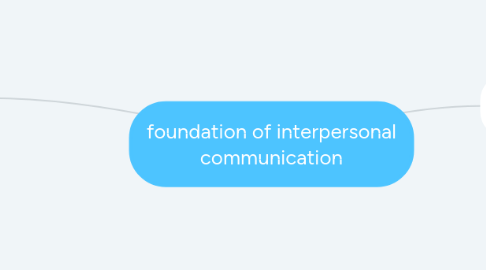
1. elements of interpersonal communication
1.1. source-receiver
1.1.1. source
1.1.1.1. person or thing that creates, formulate and sends the messages.
1.1.2. receiver
1.1.2.1. person or thing that perceives and comprehends messages.
1.2. encoding-decoding
1.2.1. encoding
1.2.1.1. the act of producing messages. example: speaking and writing.
1.2.2. decoding
1.2.2.1. the act of understanding messages. example: listening and reading.
1.3. competence
1.3.1. your ability to communicate effectively, to measure the quality of your intellectual and physical interpersonal performance.
1.4. massages
1.4.1. feedback messages
1.4.1.1. massage sent back to the speaker concerning reactions to what is said.
1.4.2. feed forward messages
1.4.2.1. information you provide before sending your primary message.
1.5. channel
1.5.1. the medium through which message are sent connecting source and receiver.
1.6. noise
1.6.1. physical noise
1.6.1.1. external interference to both speaker and listener.
1.6.2. physiological noise
1.6.2.1. created by barriers within the sender or receiver.
1.6.3. psychological noise
1.6.3.1. mental interference in speaker or listener.
1.6.4. semantic noise
1.6.4.1. speaker and listener have different meaning system.
1.7. context
1.7.1. physical
1.7.1.1. tangible or concrete environment in which communication takes place.
1.7.2. temporal
1.7.2.1. time of the day and moment in history, and also particular massages fits into certain events (time related).
1.7.3. social psychological
1.7.3.1. status relationship, role and games/
1.7.4. cultural
1.7.4.1. cultural beliefs and customs of the people communicating.
1.8. ethics
1.8.1. a moral dimension, a rightness and wrongness.
2. Principles of Interpersonal Communication
2.1. Communication is Transactional Process
2.1.1. Interpersonal Communication is a Process
2.1.1.1. view as an ever-changing process-sometimes unnoticed
2.1.1.2. each person serves simultaneously as a speaker and a listener
2.1.1.3. mutually interactive process
2.1.2. elements are interdependet
2.1.2.1. each elements of ICOM is intimately connected to the other parts and to the whole
2.1.2.2. a change any one elements causes changes in the others
2.2. Communication is Purposeeful
2.2.1. To learn
2.2.1.1. to better understand the external world
2.2.2. To Related
2.2.2.1. to establish and maintain closed relationship
2.2.3. To Influence
2.2.3.1. influence the attitudes and behaviors of others in your interpersonal encounters
2.2.4. To Play
2.2.4.1. talking to friends about your weekend activities, discussing sports or date
2.2.5. To Help
2.2.5.1. counsel another student about courses to take, offer advice to colleague
2.3. Communication is Ambiguous
2.3.1. all messages are ambiguous to some degree
2.3.2. idea that is being expressed never been communicated exactly and totally
2.3.3. people communicated just enough to give the other person a pretty clear idea of what you mean
2.4. Relationship May be Symmetrical or Complementary
2.4.1. Symmetrical Relationship
2.4.1.1. two individuals mirror each others behavior
2.4.1.2. example: if one member is passive, so is the other, if one member is jealous, so is the other
2.4.2. Complementary Relationship
2.4.2.1. two individuals engage in different behaviors
2.4.2.2. one serves as the stimulus for the others complementary behavior
2.4.2.3. the differences between the parties are maximized
2.4.2.4. example: one active and one passive, one superior and one interior, one strong and one week
2.5. Communication Refers to Content and Relationship
2.5.1. Content Aspect
2.5.1.1. refers to behavioral response expected
2.5.2. Relationship Aspect
2.5.2.1. refers to the relationship and how the communication is to be dealt with
2.6. Communication is Series of Punctuated Events
2.6.1. refers to the tendency to divide communication transaction into sequences of stimuli and response
2.6.2. everyone separates communication sequences into stimuli and response on the basis of his or her own perspective
2.6.3. understanding how another person interprets a situation on how he/she punctuates is a crucial step in interpersonal understanding
2.7. Communication is Inevitable, Irreversible and Unrepeatable
2.7.1. Inevitable (cannot be prevented)
2.7.1.1. often communication is thought of as intentional, purposeful and consciously motivated
2.7.1.2. there are times you are communicating even thought you might not think you are or might not even want to be
2.7.2. Irreversibility (cannot be reversed)
2.7.2.1. only move in one direction, cannot go back again
2.7.2.2. what you have communicated remains communicated
2.7.3. Unrepeatability (cannot be repeated)
2.7.3.1. everyone and everything is constantly changing
2.7.3.2. you can never recapture the exact same situation, frame of mind or relationship

